For this week’s GP’s Classic Steel we are going to take a look back at the bike Motocross Action Magazine proclaimed “The Greatest Bike Ever Made,” the mighty 1981 Maico MC490 Mega 2.
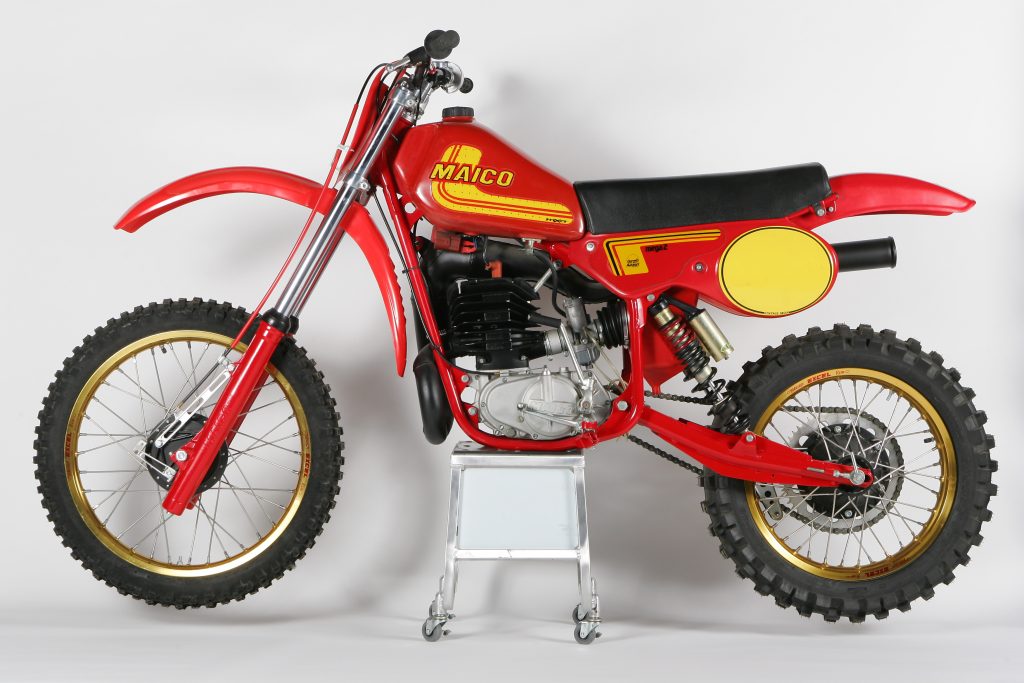
In 1981, this bike was considered the baddest machine in motocross. Its amazing combination of brute power, ease-of-use, and flawless handling has made the mega-motored German a legend. Photo Credit: Stephan LeGrand
In the 1970s, Maico was one of the most well-respected brands in motocross. They were famous for their incredible handling and nearly as infamous for their spotty reliability. Nothing handled like a Maico, and many riders were more than willing to put up with their spotty quality to enjoy carving circles around the competition. In the early seventies, that was more than enough to keep the German marque competitive, but as the Japanese began their invasion of the sport in the later part of the decade, things started to become tougher for the Old World European brands.
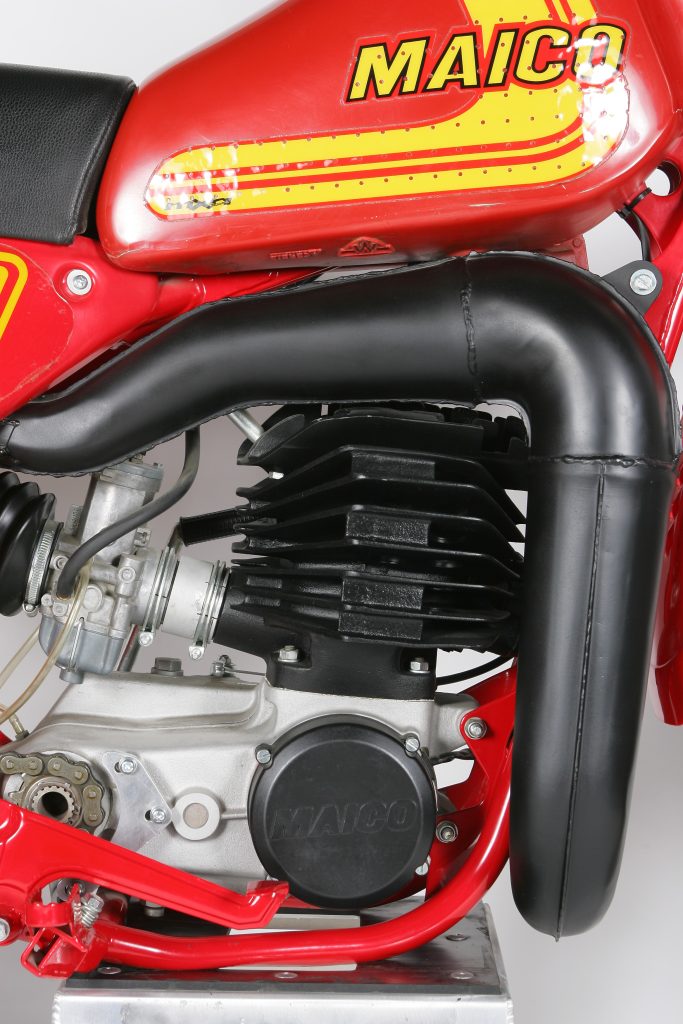
What bikes today do with fancy electronics, fuel injection, and high-tech trickery, the Mega 2 did with agricultural simplicity. In ’81, the big German lacked even such modern technology as a reed valve for the intake. Even though this basic two-stroke motor design was celebrating its 100-year anniversary in 1981, it was far from obsolete. Through thoughtful design and careful execution, the Maico engineers crafted one of the best Open-class powerbands ever for the ’81 Mega 2. Torquey and tractable from bottom to top, the 488cc monster made going fast easy. Photo Credit: Stephan LeGrand
By 1981, the upstart Japanese had developed a virtual stranglehold on the small bike classes. While Husky, Maico, and KTM continued to produce 125’s and 250’s, only European diehards rode them. In truth, it was only in the prestigious Open class that the continental brands still enjoyed a rabid following. In 1981, this old-versus-new battle culminated in one of the most competitive Open-class fields ever. For the European contingent, you had the all-new Maico MC490 Mega 2, Husqvarna’s proven 390CR, and the 123 mph monster-motored KTM 495. In the Japanese corner, you had the all-new Honda CR450R Elsinore (Honda’s first Open-classer), Kawasaki’s Uni-Trak KX420, the magic carpet Full-Floater RM465 Suzuki and the Japanese horsepower champ, the YZ465 Yamaha. It was a very diverse field of Open-class machines that offered everything from mild to wild for the 500 enthusiast. As it would turn out, it would also be the last, best stand for the Old World powers of motocross.
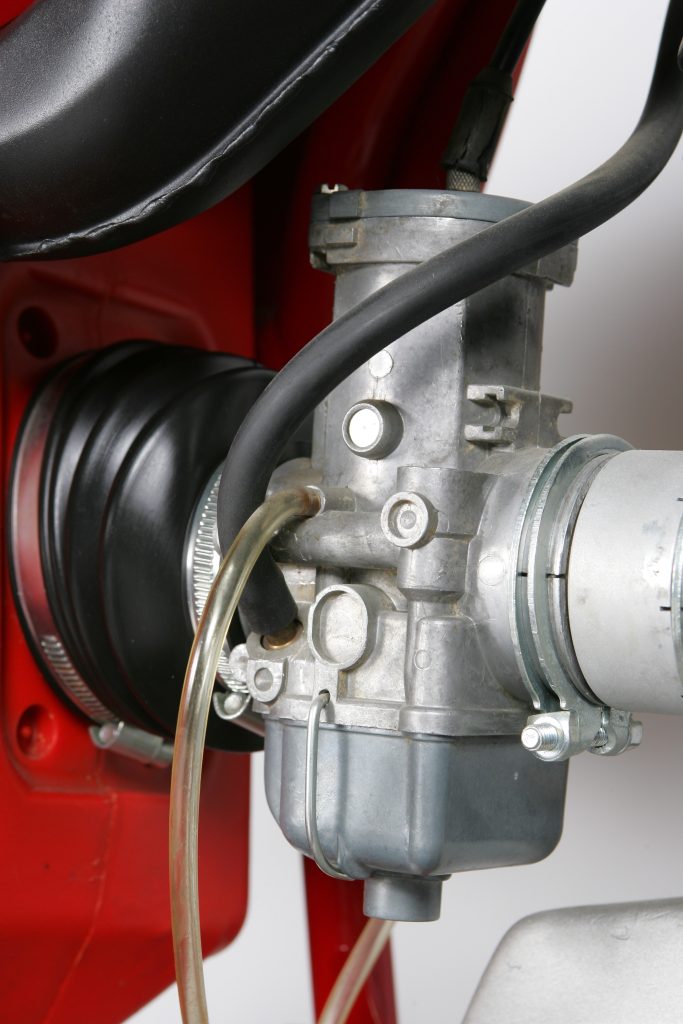
Weak link: While Maicos were always revered for their sweet power and excellent handling, their detailing often left a lot to be desired. Items like this self-ejecting (it liked to fall off on hard impacts) carburetor mounting was indicative of the German’s quality issues. Photo Credit: Stephan LeGrand
In the early and mid-seventies, most Open-class machines had been “mid-sized” machines. Usually ranging from 350cc to 400cc, they were more powerful than a 250, but not as hard to manage as a brutish 500. Then, as the decade came to a close, the class began a shift toward larger and more powerful mills. The YZ360 became a 400, and by 1980, a full 465. This upward push for more displacement meant that the quality, not just the quantity, of that power, was more important than ever. This, perhaps even more than its handling, is what made the 1981 Mega 2 such a revered motorcycle.

Hindsight: In 1981, Jody and the gang really liked the Maico 490 Mega 2, but did not actually believe it was the best Open bike available that year. That crown went to the excellent Husky 390CR, which offered a little less power, but exponentially better suspension. It was only much later, that Jody proclaimed the Maico the “Greatest Open Bike of all Time.” Photo Credit: Motocross Action
In 1980, Maico made a major misstep with their 440cc Mega 1. The Mega 1 kept the excellent 438cc motor from the ’79 Magnum but bolted it to an all-new, ultra-long travel chassis. The result was an overly-tall, ill-handling mess. For ’81, the German marque went back to the drawing board for an all-new Open-class weapon. In designing the Mega 2, Maico took a hard look at what had worked for them in the past and what had not worked on the Mega 1. With the Mega 1, the chassis had been both too tall and too short. For ’81, Maico spec’d out an all-new chassis that lengthened the wheelbase a full two inches while also lowering the seat height to acceptable levels. Many riders had also complained about the ’80 bike’s ergonomics, so the ’81 featured an all-new riding compartment. The steering stem was lowered, pegs raised and a new flatter seat and tank aided rider movement. While the new bike was lower and easier to straddle, it maintained the 12.2 Inches of travel from the ’80 model. To go with the new chassis and bodywork, a new, beefier motor was installed to complete the transformation from the mediocre Mega 1 to the mighty Mega 2.
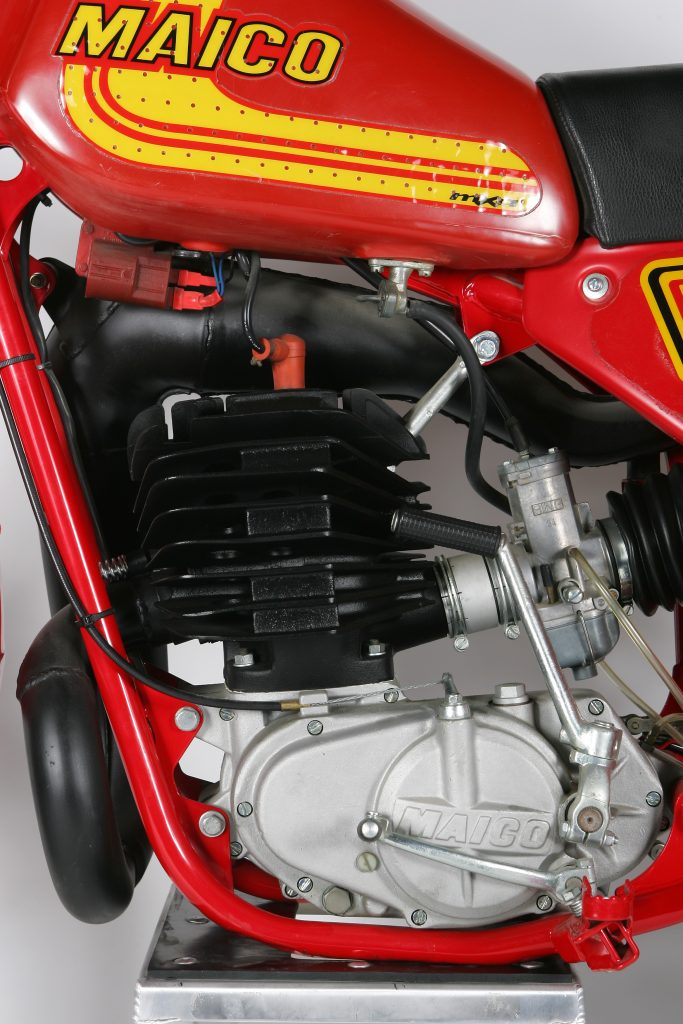
Twister: In 1981, this 86.2 x 83.0mm piston port wonder belted out a very impressive 47.2 horsepower. This put it ahead of every machine in the class other than the 50+ horsepower KTM495. While 47.2 HP may not sound like a lot in the days of 45HP 250Fs, its massive 44.4 foot-pounds of torque tell the true story. That is more than double the trench-digging twist available from a modern 250 thumper. Photo Credit: Stephan LeGrand
For the Mega 2, Maico bumped up the displacement of their Open-class mill a full 50cc to a total of 488cc. This leapfrogged the previous horsepower champ YZ465 and kept it in the running with the fire-breathing KTM495. The massive 86.2 x 83.0mm air-cooled single was rudimentary even by 1981 standards, lacking any exhaust valve trickery or even a reed valve. Mated to a deep-breathing 40mm Bing carburetor and slick-shifting five-speed tranny, the Teutonic tractor cranked out a very healthy 47.2 horsepower. That put it well ahead of all the Japanese competition (The class-leading YZ465 cranked out a mere 43 HP in ’81) and trailed only the 52 horsepower nitro-burning KTM.
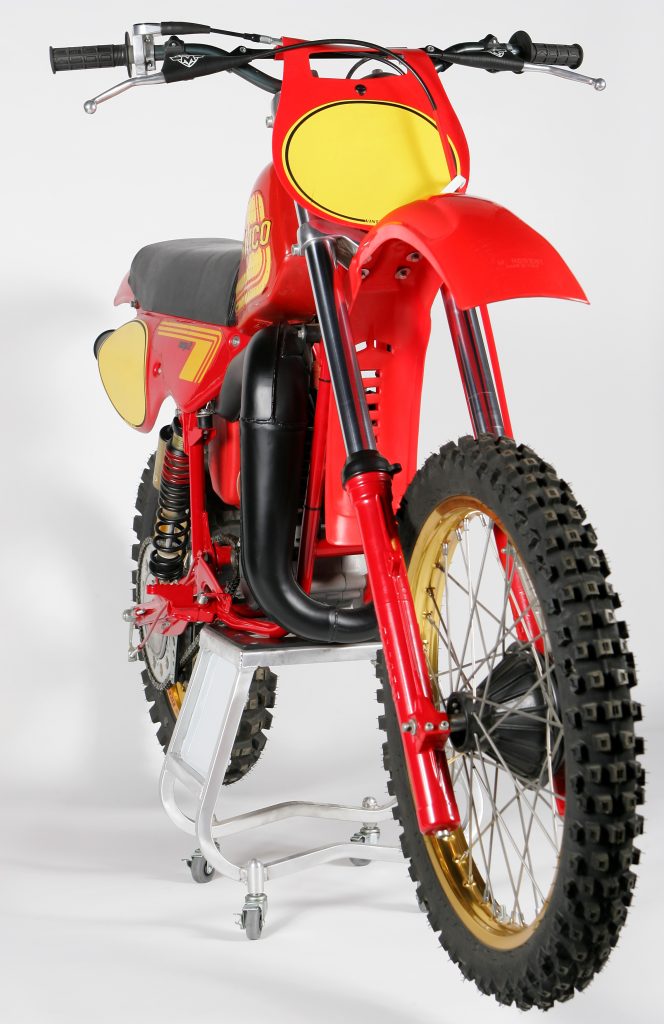
Over the years, Maico had been well regarded for their front suspension, but the 1981 Maico was not one of their best efforts. These 42mm (considered massive for the time) Maico-built front forks offered an excellent 12.2 inches of travel and air adjustability. Badly underspung and overdamped, they sagged in the travel and hydraulic locked on hard hits. Photo Credit: Stephan LeGrand
On the track, the ’81 Maico 490 offered what has been described as the perfect Open-class powerband. It cranked out a meaty and luscious flow of torque from bottom to top that hooked up and hauled. There was no sudden explosion waiting to bite you and no massive burst ready to spit you on your head. Whereas bikes like the YZ465, CR450R, and KTM495 required a deft touch to keep them under control, the big teddy bear Maico could be twisted on without fear. In actuality, its powerband was much closer to a modern four-stroke than your typical hard-hitting two-stroke. In deep sand, its lack of snap could be a disadvantage, but in most conditions, its smooth power and burly torque were a huge advantage.
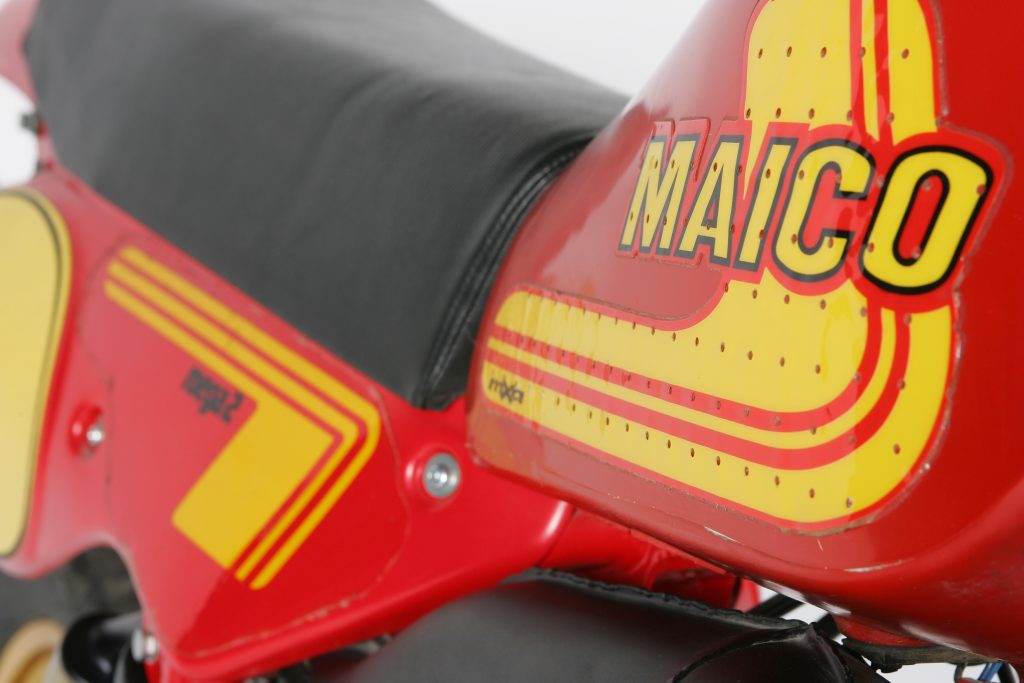
The switch to plastic tanks on the ’81 Maico’s meant two things: less money spent repairing dents and more money spent replacing decals. Original decal life was measured in minutes, not hours. Photo Credit: Stephan LeGrand
In addition to offering the sweetest motor package in the class, the muscular Maico offered moves no other 500 could match. After the misstep of 1980, the Mega 2 brought back the legendary handling Maico was famous for. The longer wheelbase tamed the wheelie-prone nature Of the Mega 1 and the new chassis offered a razor-sharp response in the corners. The mighty Mega 2 was the king of the inside line and could carve arcs under most 250-class machines. Interestingly, unlike many (most, really) other machines that can shred in the turns, the ’81 Maico did not try to terrify its pilot at speed. The Maico 490 Mega 2 was truly the jack of all trades in 1981.
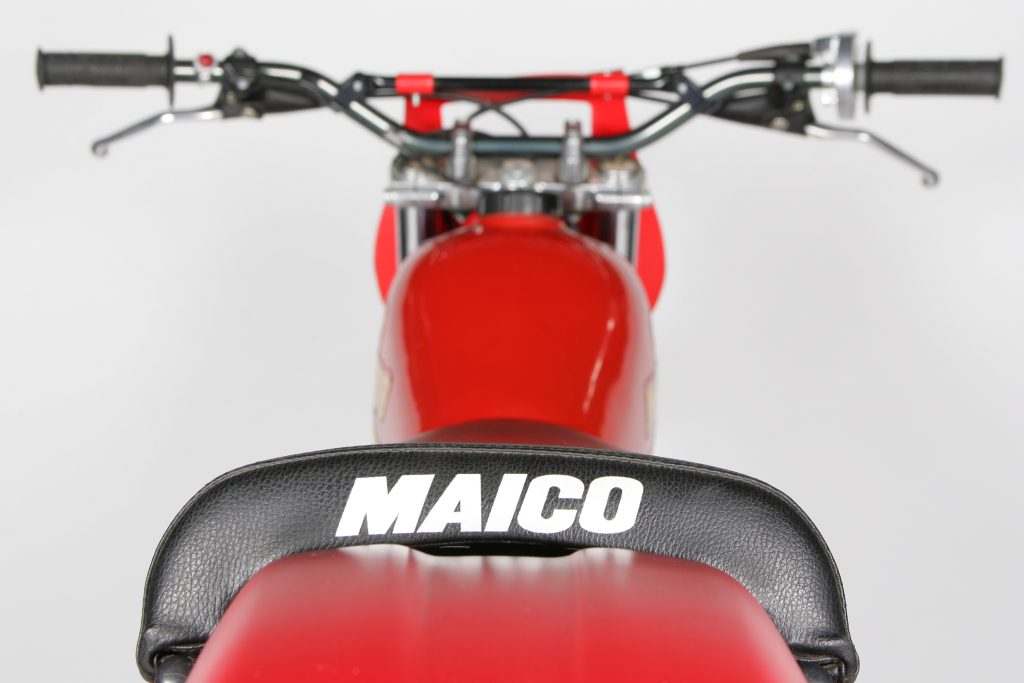
After riders panned the layout of the 1980 Mega 1, Maico put a great deal of effort into improving the ergo’s on the Mega 2. Lower bars, higher pegs, a flatter seat and a narrower tank all contributed to making the Maico a more pleasant place to burn laps. Photo Credit: Stephan LeGrand
So, was the 1981 Mega 2 truly the greatest machine ever made? In a word, no. It was certainly a great Open bike, and probably the best machine of its era, but it had quite a few issues that detract from its “all-time” status. The first, and certainly most glaring of those issues, was its lackluster suspension.
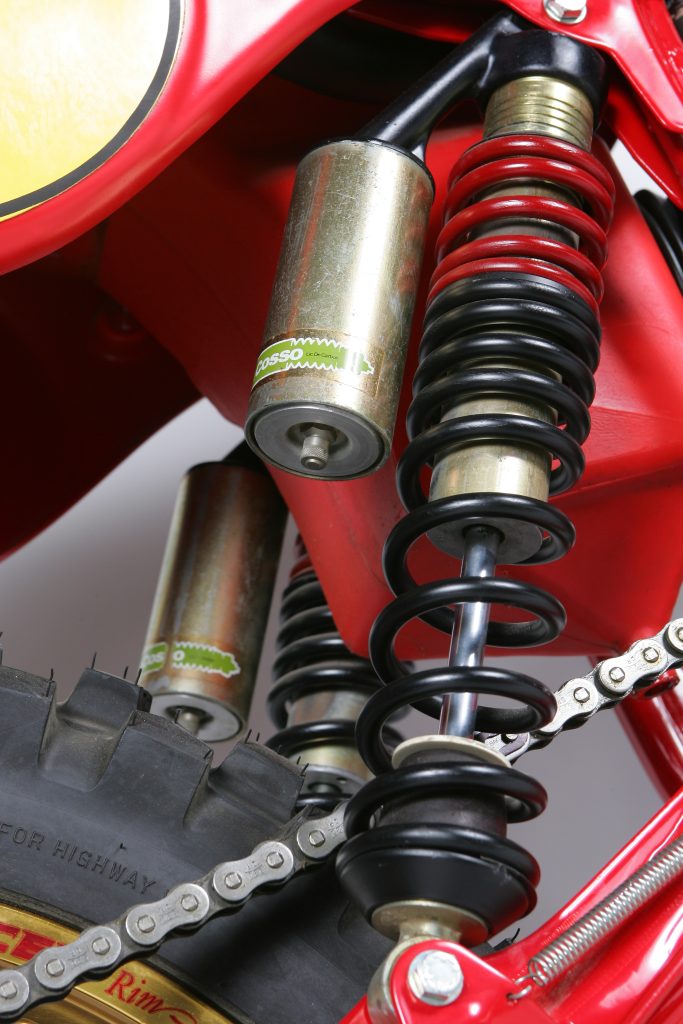
The Corte Cossa remote reservoir rear shocks that came standard on the Mega 2 offered no external adjustment but were still advertised as fully adjustable. The catch? You had to completely disassemble them to make any changes. Photo Credit: Stephan LeGrand
In 1981, both Maico and Husqvarna actually built their own forks, instead of going to an outside vendor like Showa, Kayaba, or Marzocchi. This meant they had tighter control over both the design and performance of their products. Through most of the seventies, this strategy had worked out well, as the European brand’s suspension often outperformed the components from Japan. In ’81, however, Maico missed the mark with their red-painted silverware.
 Excellent handling was a Maico trademark in 1981.
Excellent handling was a Maico trademark in 1981.
On the spec sheet, the MC490 looked to be as advanced as anything in the class in ’81. The 42mm sliders were considered massive for the time and offered an excellent 12.2 inches of travel. The forks themselves offered no external damping adjustment, but air could be added to fine-tune the ride. In stock condition, the Mega 2’s Maico sliders were poorly set up for any conditions. The stock springs were too soft for any kind of motocross use and required upwards of 12 pounds of air to be added to supplement the marshmallow fork springs. Damping was even worse, with a nasty hydraulic lock on hard hits that could actually twist the forks in the clamps. With a revalve and spring swap, they could be made to work quite well for the time, but in stock condition, they were a mess.

The Gold Standard: So just how popular was the Mega 2? In 1981, Maico sold more MC490s than Honda sold of all their motocross bikes combined! Photo Credit: Maico
Even worse than the marginal forks, were the Maico’s abysmal Corte Cossa rear shocks. From the factory, they came set up with too much compression and not enough rebound damping. This made them harsh over square edge bumps and prone to whacking you in the tail on rebound. Worst of all, they were still too soft overall and were easily bottomed over any mid-size obstacle. In truth, much of the problem with the Maico’s rear end was probably due as much to the design of the rear end as the shocks themselves. When Maico lengthened the swingarm two inches for ’81, it placed the shocks at too steep of an angle in relation to the chassis. This meant that even if you replaced the stock shocks with a set of Fox air shocks or Works performance units, it was still not going to work perfectly. In ’81, mediocre was the best you could hope for without an aftermarket swingarm and a complete revamp of the rear end.
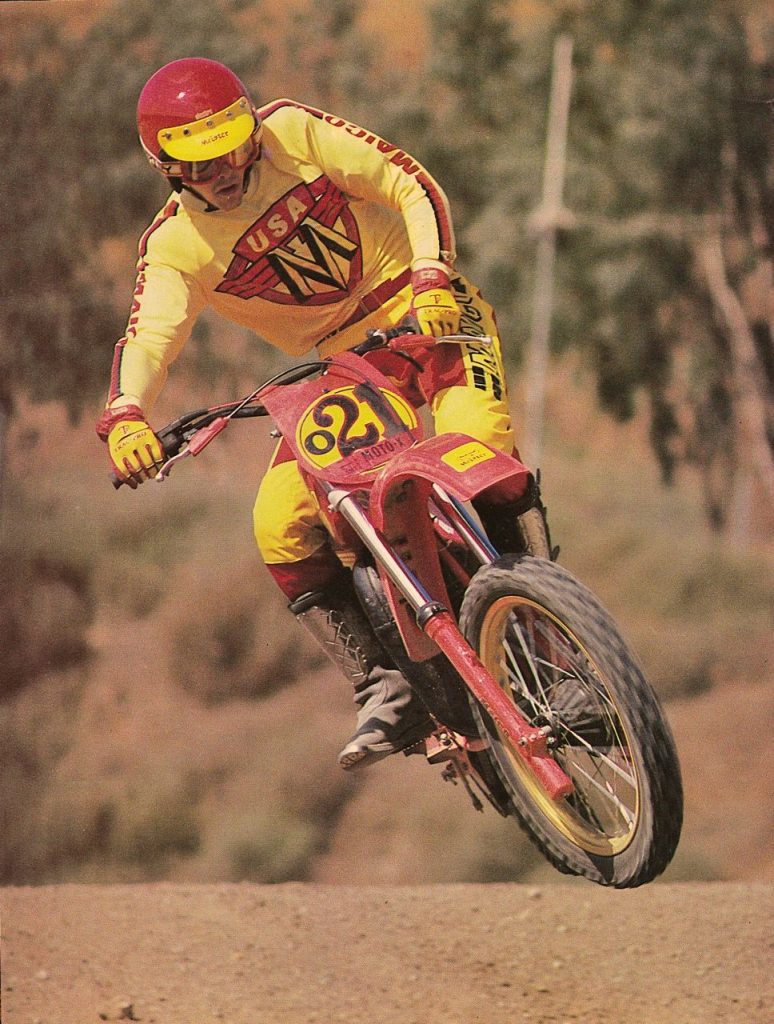
Float like a butterfly and sting like a bee: In ’81, the Maico 490 was not just one of the most powerful bikes you could buy, it was also one of the lightest. At 224 pounds, it was right at the class limit and nearly twenty pounds lighter than much of its porky competition. Photo Credit: Dirt Bike
Unfortunately, this was not the end of the MC490 rider’s woes in ’81. While the Mega 2 was far better built than earlier Maico’s, it was far from trouble-free. Most annoying, was probably the bike’s propensity to eject its carburetor on hard landings. When designing the bike, Maico used a three-inch aluminum manifold to connect the carb to the cylinder. Unfortunately, no matter how hard you tightened down the clamps, the carb would still come loose. Smart riders resorted to using a spare pipe spring to keep the Bing from jumping ship.
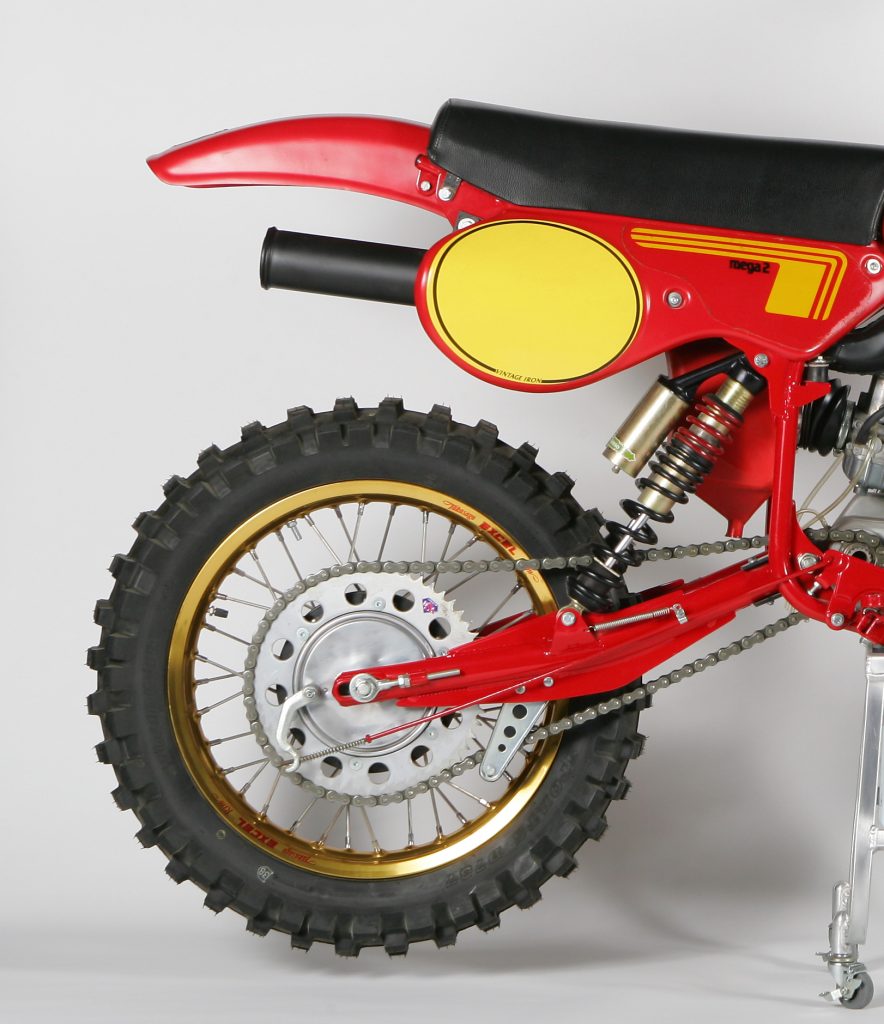
In stock condition, the Maico’s rear end was a bouncing and bottoming mess. Even worse, without an aftermarket swingarm to reposition the shocks, it was never going to be quite right. Photo Credit: Stephan LeGrand
Maico wheels were always suspect, and the Mega 2 was no exception. Savvy riders watched the cheesy spokes like a hawk and prayed for the best. The front brake was pathetic by even 1981 standards and virtually useless at retarding speed. Even worse, the front wheel had a passion for eating the flimsy stock front brake cable. Not good.
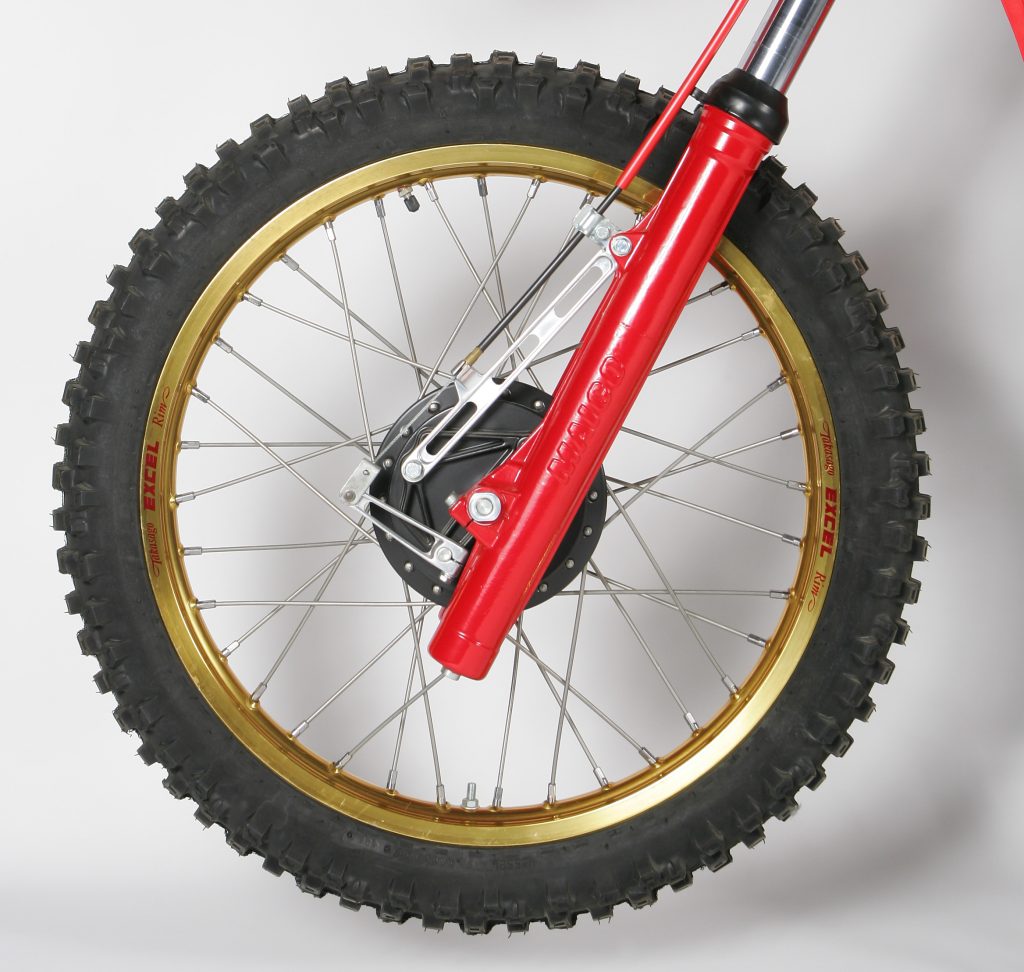
The Mega 2’s stock front brake was purely ornamental. Photo Credit: Stephan Legrand
Both the stock pipe and its associated mounting brackets were problem areas on the Mega 2. It was only a matter of time before either, and or both, cracked. Stock pegs were flimsy and bent with time. Kickstart shafts were another weak link and care had to be taken when starting the beast to avoid breaking the fragile mechanism. The last of the Maico’s weak spots was the Maico’s clutch. Clutch pull and action were both decent, but the unit used an odd set of wave washers instead of traditional clutch springs and any abuse would render it completely useless. At least the bike’s massive torque made clutch abuse unnecessary.
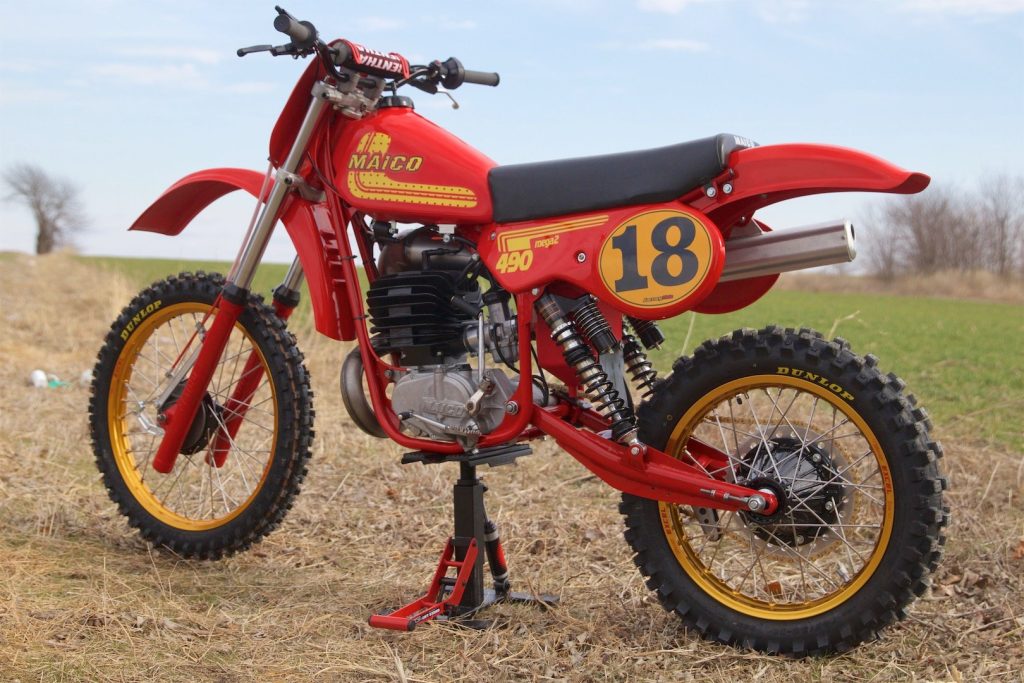
With a little fine-tuning and a few key upgrades, the Maico 490 Mega 2 makes a potent vintage racer. Even today, the Mega 2 is one fine-looking motorcycle. Photo Credit: Don Williams
In 1981, Maico produced one of the most iconic motorcycles in motocross history. The Maico MC490 Mega 2 set the standard for Open-class performance for a generation. It was fast, but easy to ride, and sharp, without being shaky. At $2699, it cost 20% more than a Japanese 500, but nobody else could produce those luscious vibes at any cost. Yes, it had suspension issues, and there were certainly reliability concerns galore, but for many people, that paled in comparison to the bike’s many virtues. In fact, Maico sold more 490 Mega 2’s in 1981 than Honda sold of all their ‘81 CRs combined! It was that good and that popular in its day.
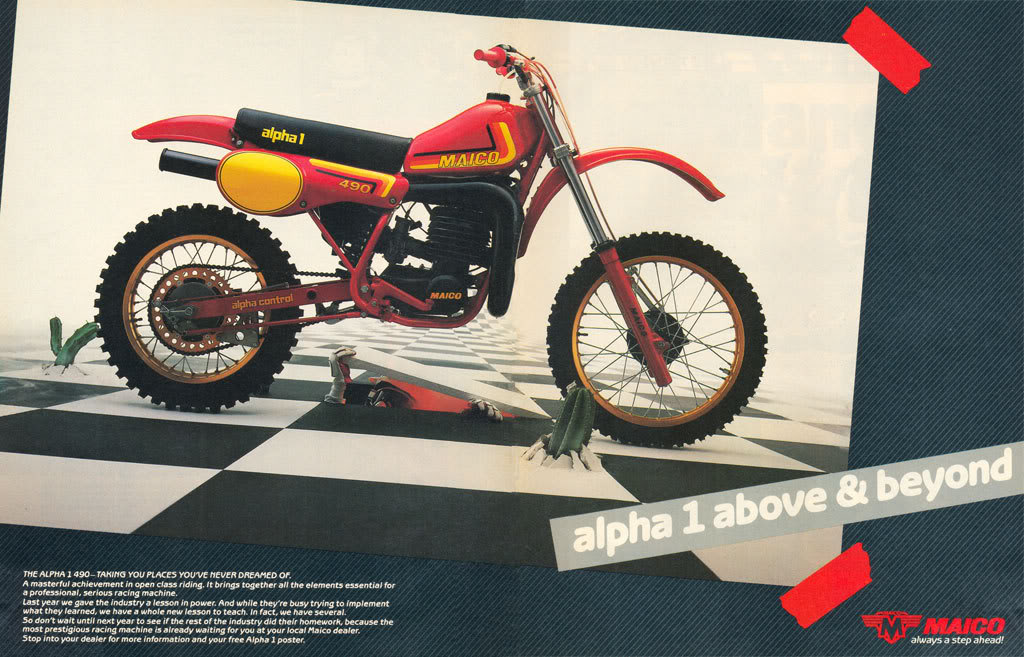
After the success of the Mega 2, Maico fans had every reason to expect big things from the new ’82 Alpha 1. Unfortunately, the bike’s new mono-shock system was poorly designed, resulting in numerous broken shocks and injured riders. A litany of lawsuits and internal fighting back in Germany would spiral the brand into bankruptcy by 1983.
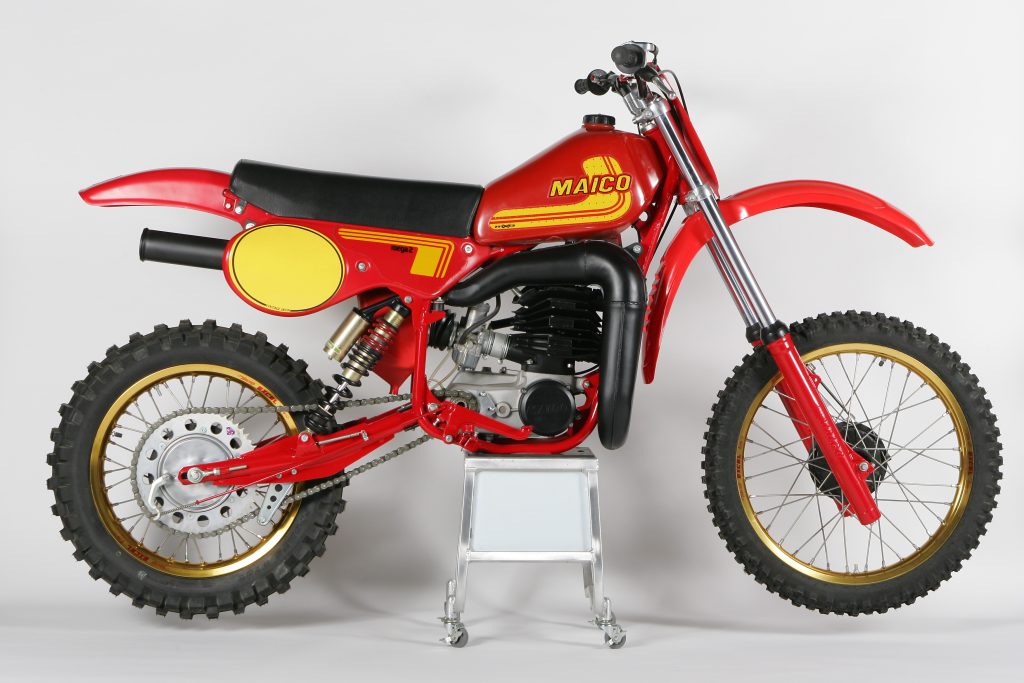
The 1981 Maico MC490 Mega 2 remains one of the most iconic machines of the 1980s. It had an awesomely fast and easy-to-ride motor, razor sharp handling and the weight of a 250. Unfortunately, it also had dismal suspension and a penchant for falling apart. While it may not be the greatest bike ever built, it does remain one of the most celebrated machines from the golden age of motocross. Photo Credit: Stephan LeGrand
Unfortunately for Maico, however, things would go horribly wrong in 1982. Originally, there were high hopes for the new 490 Alpha 1. The all-new ’82 bike was set to introduce Maico’s own version of a rising-rate linkage rear suspension system, inscrutably named “Alpha Control”. Unfortunately for the Maico faithful, however, the new system was a dismal failure. When designing the new Alpha Control system, Maico had tried to copy Honda’s Pro-Link design, but something had been lost in the translation. Maico’s version used a much more severe lever ratio than the Honda and put far too much stress on the Alpha 1’s rear shock. The result was a massive rash of bent and broken shock shafts. This also coincided with a manufacturing defect that caused Alpha 1 hubs to explode on hard impacts. Needless to say, this caused a huge problem for a brand already tagged with the name “Maico-breako” and led to numerous lawsuits. In ’83, Maico would go back to the drawing board to try and get back in the hunt, but it was a case of too little, too late. By then, Honda had introduced a Maico clone of their own, the CR480R and the rest was history. Although the Germans would continue to build bikes for several more years under Maico, and eventually M-Star name, they would never again recapture the magic of the Mega 2. For Maico, 1981 was one last bright moment in the spotlight. Calling it the greatest Open-class motocross bike of all time may be a bit of a stretch, but there is no doubt it was one fine motorcycle and a legend in its own time.
For your daily dose of old-school moto goodness, make sure to follow me on Instagram and Twitter – @TonyBlazier




